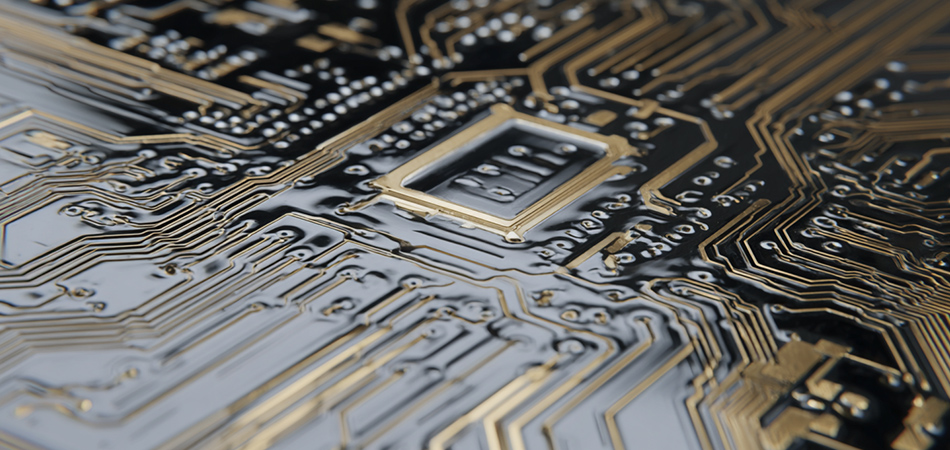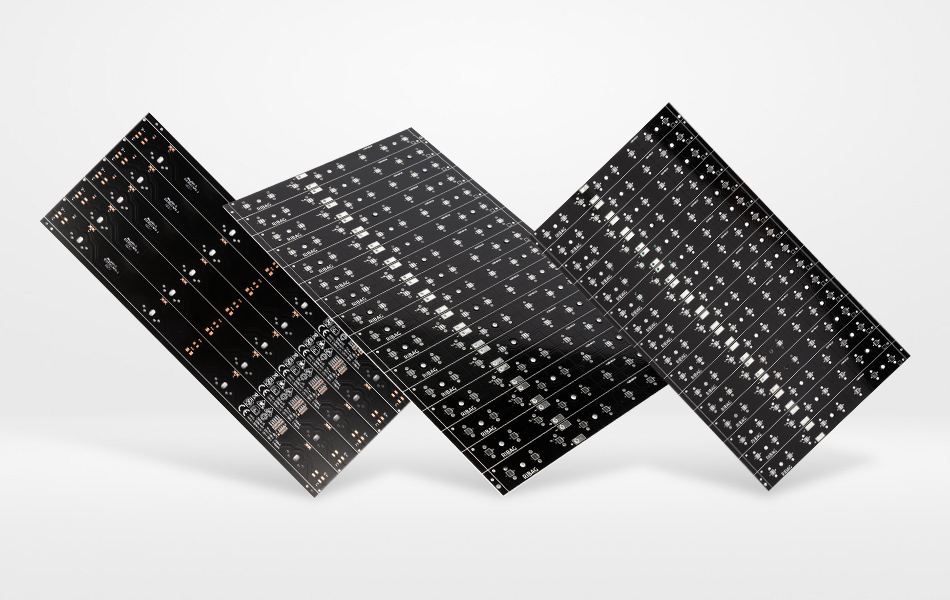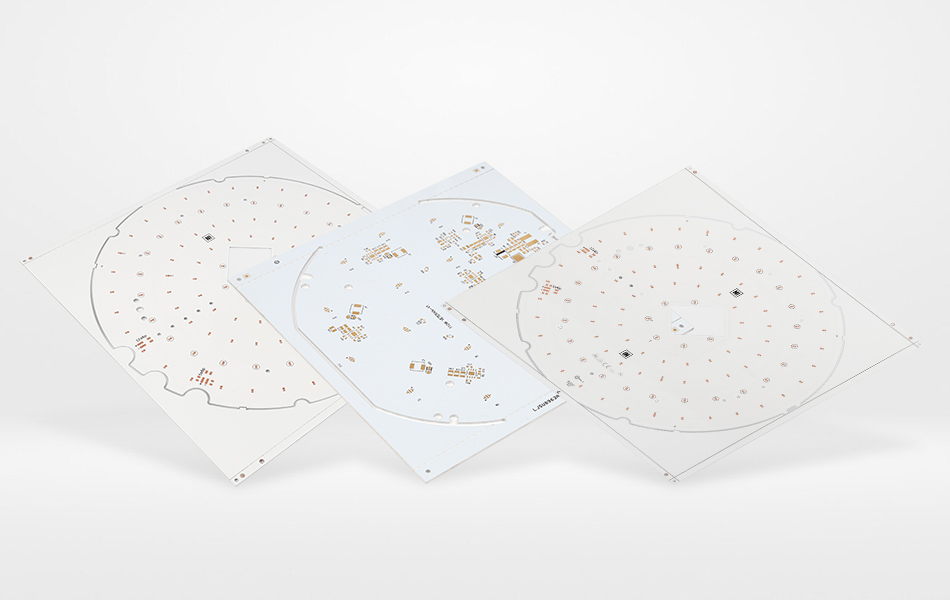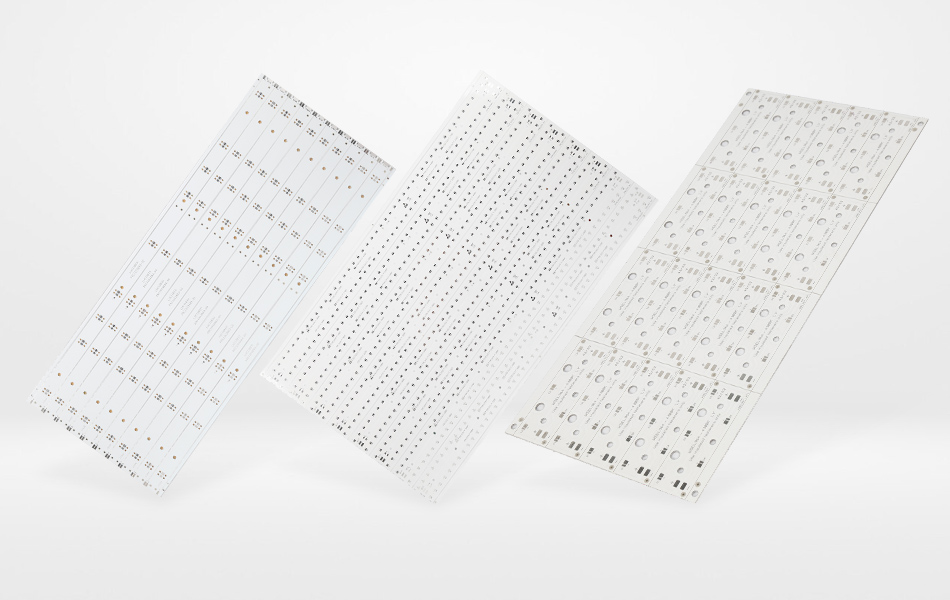-
- PCB TYPE
- PRINTED CIRCUIT BOARD PROTOTYPE ALUMINUM PRINTED CIRCUIT BOARD R&F PCB FPC HIGH FREQUENCY PCB HIGH-TG PCB HEAVY COPPER PCB HDI PCB PCB FOR LIGHTING METAL CORE PCB
time:Jun 23. 2025, 09:14:47
In the ever - evolving realm of electronics, Printed Circuit Boards (PCBs) play a fundamental role. Among the diverse types of PCBs available, Aluminum PCBs have emerged as a popular choice, especially in applications where efficient heat management is crucial. Aluminum PCBs are a type of metal - core PCB, with aluminum serving as the core substrate material. This article delves into the details of aluminum PCBs, exploring their structure, benefits, design considerations, manufacturing processes, applications, and market trends.
Structure of Aluminum PCBs
Layer Configuration
Aluminum PCBs typically feature a multi - layer structure. The core layer is the aluminum substrate, which provides excellent thermal conductivity and mechanical strength. This aluminum layer can range in thickness depending on the specific application requirements, with common thicknesses varying from 1 - 6 mm.
On top of the aluminum substrate lies the dielectric layer. The dielectric material is a key component as it has to balance two important functions: electrical insulation between the aluminum substrate and the conductive copper traces, and efficient heat transfer. Specialized thermally conductive polymers, often filled with ceramic particles such as aluminum oxide or boron nitride, are used for this layer. The thickness of the dielectric layer is optimized to ensure a good balance between electrical isolation and thermal performance, usually ranging from 0.05 - 0.3 mm.
Finally, the outer layer consists of copper traces. These copper traces are patterned to form the electrical circuits required for component interconnection and signal transmission. Copper is chosen for its high electrical conductivity, which allows for efficient flow of electrical current. The thickness of the copper layer can vary, with typical values ranging from 0.5 - 3 ounces per square foot.
Material Selection
The choice of materials for each layer in an aluminum PCB is of utmost importance. For the aluminum substrate, different aluminum alloys are selected based on the desired properties. For example, alloys like 1050 and 6061 are commonly used. Alloy 1050 offers high purity and good thermal conductivity, while alloy 6061 provides a better balance between mechanical strength and thermal conductivity.
The dielectric material is formulated to have a high thermal conductivity while maintaining good electrical insulation. The ceramic - filled thermally conductive polymers mentioned earlier are designed to enhance the thermal conductivity of the dielectric layer. The filler particles increase the effective thermal conductivity of the polymer matrix, without significantly degrading its electrical insulation properties.
High - purity copper is used for the copper traces. The purity of copper directly impacts its electrical conductivity. The copper foils used are carefully selected to meet the current - carrying capacity and heat - dissipation requirements of the PCB design.

Advantages of Aluminum PCBs
Enhanced Heat Dissipation
One of the most significant advantages of aluminum PCBs is their superior heat - dissipation capabilities. In electronic devices, especially those with high - power components such as power transistors, LEDs, and high - performance integrated circuits, heat generation is a major concern. Aluminum PCBs can quickly transfer the heat generated by these components away from the source. The aluminum substrate acts as a large heat sink, effectively distributing the heat across its surface and facilitating its dissipation into the surrounding environment. This helps to keep the components within their optimal operating temperature range, which in turn improves the performance and reliability of the electronic device. For example, in LED lighting applications, aluminum PCBs can prevent the LEDs from overheating, maintaining their brightness and extending their lifespan.
Mechanical Robustness
The aluminum substrate provides aluminum PCBs with enhanced mechanical strength. Aluminum is a relatively lightweight yet rigid material, which makes the PCB resistant to bending, vibration, and shock. This mechanical robustness is particularly valuable in applications where the PCB is subjected to harsh physical conditions. In automotive electronics, for instance, PCBs are exposed to continuous vibrations and temperature fluctuations while the vehicle is in motion. Aluminum PCBs can withstand these conditions without deforming or causing damage to the components mounted on them, reducing the need for frequent maintenance and replacement.
Extended Component Lifespan
By efficiently managing heat, aluminum PCBs contribute to extending the lifespan of electronic components. High temperatures can accelerate the degradation of components, leading to premature failure. When components are mounted on aluminum PCBs, the lower operating temperatures achieved through effective heat dissipation slow down the aging process. This not only reduces the cost of component replacement but also improves the overall reliability of the electronic system. For example, in power electronics applications, where high - power components generate a significant amount of heat, the use of aluminum PCBs can greatly increase the lifespan of these components.
Environmental Friendliness
Aluminum is a highly recyclable material, making aluminum PCBs an environmentally friendly choice. At the end of a product's life cycle, the aluminum substrate can be easily separated and recycled, reducing electronic waste. Additionally, the efficient heat - dissipation capabilities of aluminum PCBs can reduce the need for additional cooling components in electronic devices. This not only saves energy but also makes the device more sustainable in terms of its overall environmental impact.

Design Considerations for Aluminum PCBs
Thermal Design
Component Placement
Proper component placement is crucial for effective thermal management in aluminum PCBs. Heat - generating components should be strategically positioned to maximize heat transfer to the aluminum substrate. Placing these components directly over the substrate or in close proximity to thermal vias can significantly enhance heat dissipation. Thermal vias are small conductive holes that connect different layers of the PCB to the aluminum substrate, providing an additional path for heat to flow. Grouping components based on their heat - generation levels and placing high - heat - generating components in areas with better heat - dissipation paths can also optimize the thermal performance of the PCB.
Thermal Via Design
The design of thermal vias is another important aspect of thermal design in aluminum PCBs. The size, number, and distribution of thermal vias need to be carefully optimized based on the heat - generation characteristics of the components. Designers often use specialized thermal simulation software to analyze the heat flow within the PCB and determine the most effective thermal via configuration. This ensures that heat is efficiently conducted from the components to the aluminum substrate, improving the overall thermal performance of the PCB.
Heat - Sink Integration
In some applications, integrating a heat sink with the aluminum PCB can further enhance heat dissipation. A heat sink is a passive cooling device that increases the surface area available for heat transfer. To achieve effective heat transfer, good thermal contact between the heat sink and the aluminum substrate is essential. This can be achieved using thermal interface materials, such as thermal paste or thermal pads. The design of the heat sink, including its size, shape, and fin configuration, should be tailored to the specific heat - dissipation requirements of the PCB.
Electrical Design
Trace Routing
Trace routing in aluminum PCBs requires careful consideration to ensure reliable signal transmission. Designers need to take into account factors such as signal integrity, impedance matching, and crosstalk. The presence of the aluminum substrate can also affect the electromagnetic fields around the copper traces, which needs to be accounted for during the design process. Specialized PCB design software can be used to optimize the trace widths, lengths, and spacings to meet the electrical requirements of the circuit.
Power and Ground Plane Design
Power and ground plane design is crucial for power distribution and reducing electromagnetic interference (EMI) in aluminum PCBs. Well - designed power and ground planes ensure a stable electrical supply to the components. Integrating power and ground plane design with thermal design, such as using thermal vias to connect the planes to the aluminum substrate, can help manage the heat generated by the electrical current flowing through the planes.
Design for Manufacturability
Adhering to design - for - manufacturability (DFM) principles is essential when designing aluminum PCBs. Using standard component footprints, avoiding complex shapes, and ensuring compatibility with manufacturing processes can simplify production and reduce costs. Designers should also provide clear guidelines for fabricators, including soldering process specifications and feature tolerances. This helps to ensure that the PCB can be manufactured efficiently and with high quality.

Manufacturing Processes of Aluminum PCBs
Material Preparation
The manufacturing process of aluminum PCBs begins with material preparation. High - quality aluminum sheets are selected and cut to the required size and shape for the substrate. The aluminum sheets may undergo surface treatment, such as degreasing and anodizing, to improve the adhesion of the dielectric layer. The dielectric material, usually in the form of a pre - impregnated film or a liquid resin, is prepared by mixing the base resin with thermally conductive fillers. High - purity copper foils are also prepared to the desired thickness.
Lamination
Lamination is the process of bonding the aluminum substrate, dielectric layer, and copper foils together. Heat and pressure are applied to cure the dielectric material and create a strong bond between the layers. Precise control of lamination parameters, such as temperature, pressure, and time, is necessary to ensure the quality of the laminate. Defects such as voids, delaminations, or uneven bonding can affect the performance of the PCB.
Drilling and Plating
After lamination, drilling is performed to create holes for vias, component mounting, and electrical connections. High - precision drilling machines are used to ensure accurate hole placement and clean hole walls. The drilled holes are then electroplated with copper to create electrical connections and provide a solderable surface for component attachment. The plating process needs to be carefully controlled to ensure uniform copper deposition and good adhesion.
Circuit Patterning
Circuit patterning is the process of creating the electrical circuits on the copper layer. Photolithography is a commonly used technique for circuit patterning. A photosensitive resist is applied to the copper surface, exposed to ultraviolet light through a patterned mask, and then developed. The remaining copper is etched away to form the desired electrical circuits. Precise control of the etching process is required to ensure accurate trace widths and no shorts or open circuits.

Applications of Aluminum PCBs
LED Lighting
Aluminum PCBs are widely used in LED lighting applications. LEDs generate a significant amount of heat during operation, and efficient heat management is essential to maintain their performance and lifespan. Aluminum PCBs can effectively dissipate the heat generated by LEDs, ensuring that they operate at optimal temperatures. The mechanical strength of aluminum PCBs also makes them suitable for various lighting fixtures, including those used in outdoor and industrial environments.
Power Electronics
In power electronics applications, such as power supplies, inverters, and motor drives, high - power components generate substantial heat. Aluminum PCBs are used to manage this heat, improving the efficiency and reliability of the power electronics systems. The ability of aluminum PCBs to handle high currents and dissipate heat effectively makes them an ideal choice for these applications.
Automotive Electronics
The automotive industry is increasingly adopting aluminum PCBs for various applications, including engine control units, advanced driver - assistance systems, and infotainment systems. The harsh environment in vehicles, with its vibrations, temperature fluctuations, and mechanical stress, requires PCBs with high mechanical strength and good heat - dissipation capabilities. Aluminum PCBs can meet these requirements, ensuring reliable operation of automotive electronics.
Telecommunications
In telecommunications equipment, such as base stations and routers, high - power components generate a significant amount of heat. Aluminum PCBs are used to manage this heat, ensuring stable signal processing and transmission. The efficient heat - dissipation capabilities of aluminum PCBs help to maintain the performance of the telecommunications equipment, even in high - heat - generating environments.
Consumer Electronics
Consumer electronics, such as smartphones, tablets, and laptops, are also benefiting from the use of aluminum PCBs. As these devices become more powerful, the need for effective heat management becomes more critical. Aluminum PCBs can help prevent performance throttling due to overheating, enhancing the user experience and extending the lifespan of the devices.

Market Dynamics of Aluminum PCBs
Market Growth
The market for aluminum PCBs is experiencing significant growth. The increasing demand for high - performance electronics in various industries, such as automotive, telecommunications, and consumer electronics, is driving the growth of the aluminum PCB market. The need for efficient heat management in these applications is leading to the widespread adoption of aluminum PCBs. Additionally, the development of new and improved manufacturing processes is making aluminum PCBs more cost - effective, further fueling market growth.
Competitive Landscape
The aluminum PCB market is highly competitive, with numerous manufacturers vying for market share. Key competitive factors include product quality, cost - effectiveness, technological innovation, and customer service. Manufacturers are constantly investing in research and development to improve the performance of their aluminum PCBs and to develop new and innovative products. They are also focusing on optimizing their manufacturing processes to reduce costs and improve production efficiency.
Challenges
Despite the growth opportunities, the aluminum PCB market also faces several challenges. One of the main challenges is the high cost of materials and manufacturing processes. The use of specialized materials, such as thermally conductive polymers and high - purity copper, and the complex manufacturing processes involved in producing aluminum PCBs contribute to their relatively high cost. Another challenge is the need for continuous technological innovation to meet the evolving requirements of the electronics industry. Manufacturers need to invest in research and development to develop new materials and manufacturing techniques to improve the performance of aluminum PCBs.
Future Trends
Looking ahead, the aluminum PCB market is expected to witness several trends. One of the key trends is the development of more advanced materials with even better thermal and electrical properties. This will enable the production of aluminum PCBs with improved performance. Another trend is the integration of aluminum PCBs with emerging technologies, such as 5G, the Internet of Things (IoT), and artificial intelligence (AI). As these technologies continue to develop, the demand for high - performance PCBs, including aluminum PCBs, will increase. Additionally, there will be a greater focus on sustainable manufacturing processes to meet environmental requirements.
Conclusion
Aluminum PCBs have become an essential component in modern electronics, offering numerous advantages such as superior heat dissipation, mechanical robustness, and extended component lifespan. Their applications span across various industries, including LED lighting, power electronics, automotive electronics, telecommunications, and consumer electronics. While the market for aluminum PCBs faces challenges such as high costs and the need for continuous innovation, the growth opportunities are significant. As the electronics industry continues to evolve, aluminum PCBs are likely to play an increasingly important role in enabling the development of more efficient, reliable, and high - performance electronic devices.

Got project ready to assembly? Contact us: info@apollopcb.com



We're not around but we still want to hear from you! Leave us a note:

Leave Message to APOLLOPCB
